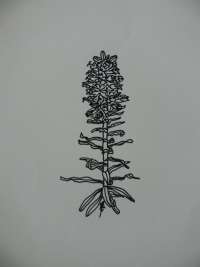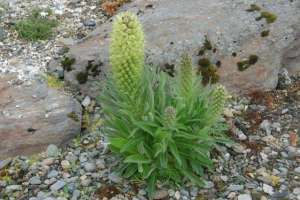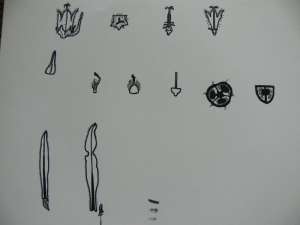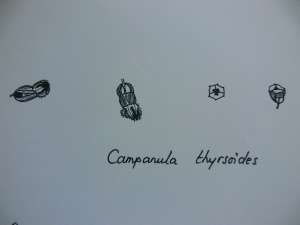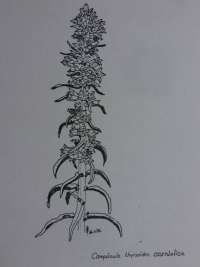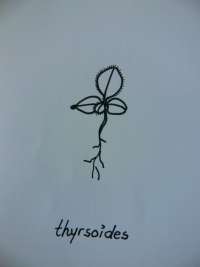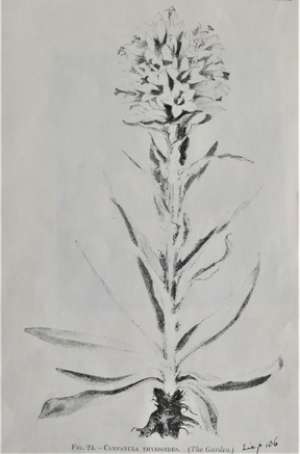Inhoud
thyrsoides
Also thyrsoidea
Campanula thyrsoides
L. (1753)
Infrageneric Taxa
Fam. des Campanulacées. Section 1: Calice accompagné d'appendices foliacés. Groupe 2: - 3 stigmates, capsule á 3 loges1)
Nomenclatuur
Section III: Cervicaria Neilr.(1859)2)
Campanula thyrsoides x Campanula betulifolia = ? more yellow colorSynonym: Campanula thyrsoidea L. (1763)
Habitus
A remarkable biennial species with densely flowered pyramidal spikes of pale sulpher flowers, each plant developing one spike only.3)
Perenni. Spiga breve. Calice a lobi ovali-lanceolati. Corolla giallo-pallida. Rd. grossa, carnosa. Fusto grosso, fistoloso, semplice, assai peloso, deneam. foglioso massime alla base (1-5dm.).4)
Coarse, monocarpic. Flower stems erect, simple, very leafy, to 2 ½ ft., terminating in dense, but elongate, bracted spikes.
Campanula Wannarii. Steli alti circa cm. 30. Nonche moltissima altre entita quali Campanula muralis Vill., delle Alpi orientali, Campanula excisa, Schleich., delle Alpi centrali, Campanula thyrsoides L., delle Alpi centrali ed orientali, Campanula Zoysii Wulf., delle rupi calcaree delle Alpi orientali, Campanula Tommasiniana Port., delle Alpi estremo-orientali ed Istria, Campanula Morettiana, Rchb., delle Alpi centrali, Campanula rhomboidalis L., ecc., tutte a fioritura estiva (giugno-settembre). 5)
Leaves
Rosette leaves lanceolate to linear, to 6 in. long, stiff-hairy.
Fg. lanceolate o lineari, intere o denticolate, ottuse all'apice, peloso-ispide, le super. un po'abbraccianti. Spiga oblunga o piu rr. ovale; bratteole ovali-lanceolate, lungam. cigliate, come pure i lobi del calice.6)Flowers
Flower measuring,between 15 - 25mm (5/8 to 1 inch.)7)
Corolla cream or yellowish, to 1 in. Corolla lunga 16-22mm., barbata specialm. sui lobi, che sono ovali e ricurvi in fuori.8)Fruit
Seed available, in small quantity. Species actually grown or used for breeding 9) Kapsel nahe am Grunde aufspringend (Hangende Kapseln springen meist nahe am Grunde, aufrechte nahe den Kelchb. auf. Man kann daher im Allgemeinen die Art des Aufspringens aus der Stellung der verbluhten Bl. erschliessen, besonders wenn diese gestielt sind.) Sect. I Medium Tourn. (als Gatt.). B. Triloculares. Kapsel 3facherig (seltener bei ein- und derselben Art hier und da auch 5facherig) 10)
* Campanula thyrsoides L. 1374-81. De: University, Newcastle upon Tyne, England. 26-2-81. Descr.: sem.11)
Varieties
Campanula thyrsoides ssp. carniolaca
Seed available, in small quantity. Species actually grown or used for breeding 12)- Campanula thyrsoides var. clusii
- Campanula thyrsoides var. multicaulis
- Campanula thyrsoides var. quorumdam
Cultivars
Campanula thyrsoides cv. 'Carniolica' is offered 13).
Germination
Breeding
MATERIALS NEEDED
When breeding within a genus, the collection of all its species will help, since a few of them may carry a specific gene. In breeding for yellow color, why not try Campanula makashvillii, Campanula sulphurea, Campanula ereophilum, Campanula vidalii, Campanula thyrsoides, or Campanula betulifolia? Out of the 300 species available, we begin with the 180 we believe most suitable.14)Origin
I was much struck with this plant on the ascent of the Furkahorn. At 9,000 feet I saw several acres of it, and it appeared to be the only vegetation on one rocky slope-a wonderful sight for the botanist-butthe plant is of no real beauty for garden-propagated seed. (Fig.24).15)
Alps, Europe, Yura, Balcan
Prati e pascoli, rara: Alpi goriz., carn.. friul. sul Montasio, bellun. sul M. Doana, veron., alto-atesine in V. Venosta, bresc., comasche, piem. e Mar.; 4-6. (Giura Alpi Balc.).16)Use
Le Campanula sono entrate nei giardini fino dalla seconda meta del xvi secolo, secondo le testmonianze di Gerard e di Clarici. Tra il 1596 e il 1597 Gerard raccolse in Inghilterra esemplari di Campanula persicaefolia, Campanula pyramidalis e Campanula medium che nella flora spontanea inglese non esistono: il che significa, dando tempo al tempo, che probabilmente in Italia erano state trasportate, dallaliberta dei campi al chiuso degli orti, forse parecchi decenni prima. Con certezza sappiamo che nei giardini francesi furonointrodotte nel 1774 la Campanula carpatica, nel 1779 la Campanula alpina e la Campanula pulla, nel 1783 la Campanula sibirica, nel 1788 la Campanula versicolor e la Campanula mollis; in Inghilterra nel 1774 la Campanula carpatica, nel 1775 la Campanula thyrsoides e nel 1779 la Campanula pulla.17)
Culture et multiplication: cette belle espéce demande un sol bien drainé. Elle se multiplie par semis, á effectuer en mai-juin. Les jeunes plants sont mis en place soit en septembre, soit en mars. La Campanule en thyrse (Campanula thyrsoides L.) se distingue de la Campanule en épi par ses fleurs jaunes pâles et son épi large et plus court. Méme culture.18)
Od mnohych druhú se v kulture péstuji bílé formy, které obcas nacházíme i ve volné prírodé. Jsou vsak zvonky, které kvetou vyhradné bíle, napr. C. alliarifolia, príp. spinavé bíle az zlutavé kvete C. thyrsoides.19)


